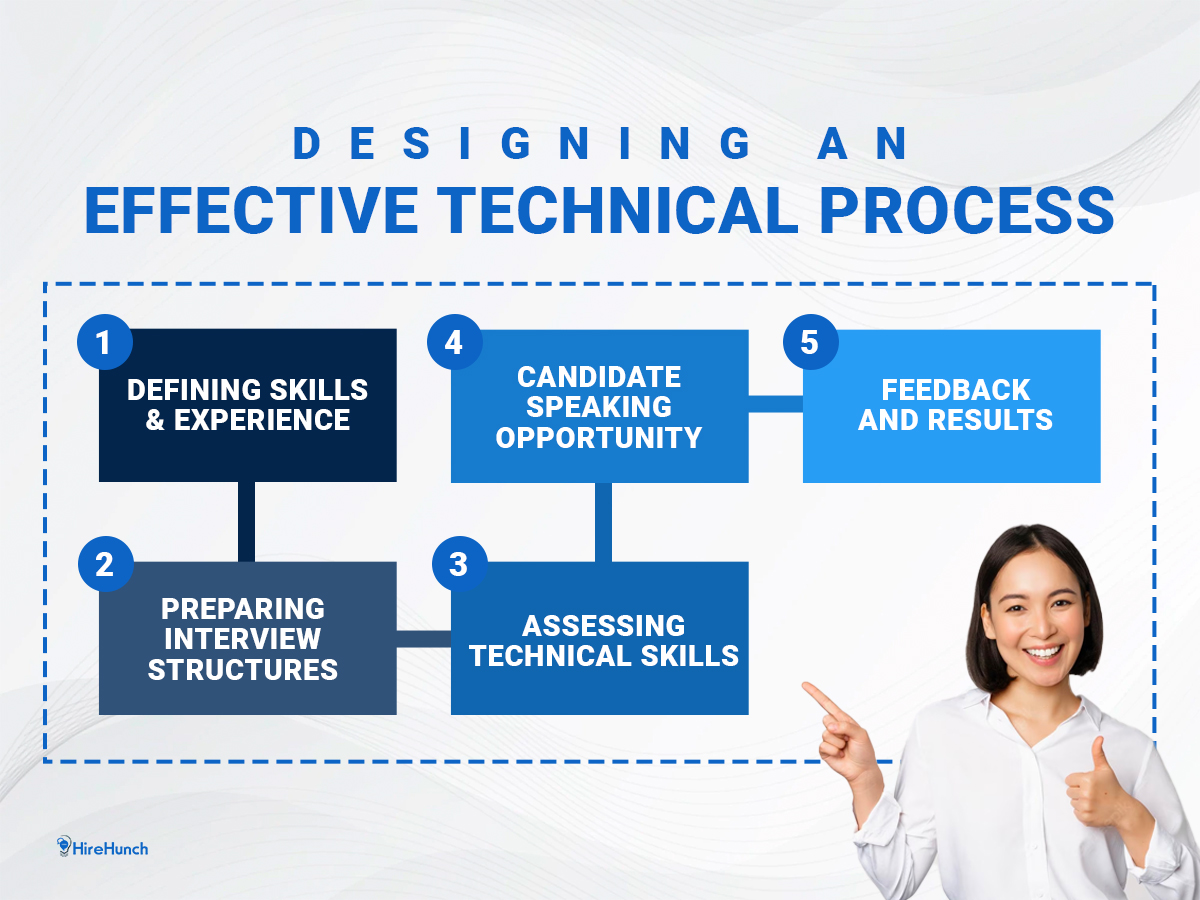How to Design an Effective Technical Hiring Process?

Introduction
Hiring technical talent can be an overwhelming and daunting task. With so many candidates to choose from, it’s essential to have a thorough and well-designed hiring process in place in order to make the best decisions for your organization. This blog post will provide you with the necessary strategies on how to design an effective technical hiring process. By utilizing these strategies, you can ensure that you hire the best person for the job and streamline your overall recruitment process.
Strategies to Design an Effective Technical Hiring Process
Here are the necessary strategies and steps in the recruitment process for designing effective technical hiring:
Define the candidate profile
When designing an effective hiring process, it is important to first define the candidate profile. This will help ensure that the process is focused and efficient. The candidate profile should include the following:
- The skills and experience required for the position
- The desired personality traits of the ideal candidate
- The level of education or training necessary
- Any other relevant information that will help identify the ideal candidate
With a well-defined candidate profile, the technical hiring process can be designed to effectively attract, assess, and select the best candidates for open positions.
Recruitment methods
There are a number of different recruitment methods that can be used to attract technical candidates. Some common methods include:
- Job postings on online job boards or company websites
- Headhunting or recruiting through personal networks
- Using social media platforms to reach out to potential candidates
- Hosting career fairs or hackathons
Each of these methods has its own advantages and disadvantages, It’s important to choose the right mix of strategies to fit your needs. For example, job postings are a great way to reach a large number of people, but they can be expensive and time-consuming to create. Headhunting can be more targeted, but it can be difficult to find qualified candidates this way.
The most important thing is to make sure that your recruitment process is effective and efficient. The best way to do this is to work with a professional recruiting firm that specializes in technical placements. They will have the experience and resources needed to help you find the best candidates for your open positions.
Streamline the interview process
The interview process is one of the most important aspects of hiring, especially when it comes to technical roles. There are a few key things to keep in mind when designing an effective interview process:
- Define the skills and experience required for the role.
- Create a consistent structure for all interviews.
- Ask questions that assess the candidate’s technical skills and knowledge.
- Give candidates ample opportunity to ask their own questions.
- Provide feedback to all candidates, regardless of whether they are successful or not.
Moreover, outsourcing the technical interviews to interviewing platforms like HireHunch is the best option for businesses to focus their team’s bandwidth on important tasks and seamlessly streamline their tech recruitment process. HireHunch helps businesses to evaluate the skills of their tech candidates and save the bandwidth of the tech team by conducting the initial rounds of interviews and shortlisting top candidates for the final interview.
After the candidate is shortlisted, there are a few more steps that follow.
Cultural fit assessment: The probability of a job candidate being able to conform and adapt to the core values and collective behaviors that comprise an organization is referred to as cultural fit. Human resource departments consider cultural fit and functional fit when evaluating candidates for employment. Thus, after or during the interview, employers will assess if the candidates can fit into the culture of the organization.
Offer rollout and negotiation: Once it is decided that the candidate fits well within the culture of the organization, the offer is rolled out to the candidate, and offer negotiation will be discussed with the candidate immediately. The offer letter will be rolled out after both the candidate and the employer have agreed to a common term.
Engaging with the candidate frequently to improve the hiring ratio: Candidate engagement helps to mitigate the growing issue of applicant dropouts. It also encourages new employees to be happier when they begin working with the organization. So, once all the formalities are complete, the employer must keep engaging with the candidate frequently to keep them interested in the position. Connect with the candidate to know when they will join the organization, their preferred mode of work, or any other relevant information.
Onboarding: When you bring a new technical employee on board, there are a few key things you can do to set them up for success. First, give them a clear understanding of their role and responsibilities. Make sure they have the tools and resources they need to do their job and introduce them to the team they’ll be working with. Finally, provide new hires with a structured onboarding program that can help them transition into their new role more smoothly and increase the chances that they will be successful in their new position.
A reference check is a procedure in the hiring process that is used by employers and recruiters to learn more about a candidate by getting in touch with their previous employers, schools, and so forth. A reference check can happen at any stage of the hiring process to make sure everything mentioned by the candidate about themself is true.
Evaluating the Effectiveness of the Process
The most important part of designing a technical hiring process is evaluating its effectiveness. There are a few key metrics you can use to do this:
Time to hire: This measures how long it takes from when a position is posted until an offer is extended and accepted. A shorter time to hire means that the process is efficient and effective.
Quality of hire: This measures the performance of the new hire in their role. High quality of hire means that the process was successful in finding a candidate who will be successful in their role.
Cost per hire: This measures the cost of the entire hiring process, divided by the number of hires made. A lower cost per hire means that the process is more efficient and effective. It not only measures the upfront cost, including wages of tech and TA resources and tools used but could also be used to measure lost time in terms of opportunity cost or delays to generate better ROI.
Retention rate: This measures how long new hires stay with the company. A higher retention rate means that the process was successful in finding candidates who will be happy in their roles and stay with the company for a long time.
By measuring these metrics, you can evaluate how effective the recruitment process is and can make necessary adjustments if needed.
Conclusion
Designing an effective technical hiring process can be a challenge, but it is possible with the right approach. By focusing on identifying the best candidates through resume reviews, creating an engaging interview experience, and leveraging technology for improved efficiency of your recruitment efforts, you can ensure that the technical hiring process is successful each time. With these tips in mind and a dedicated effort to find top talent for your company, you are sure to design an effective technical hiring process.



